
Jacob de Formentrou or Jacob de Fourmentrou [1] (b. between 1620 and 1625 - d. after 1668) was a Flemish Baroque painter active in Antwerp who specialized in the genres of merry companies and gallery paintings.

Jacob de Formentrou or Jacob de Fourmentrou [1] (b. between 1620 and 1625 - d. after 1668) was a Flemish Baroque painter active in Antwerp who specialized in the genres of merry companies and gallery paintings.
Very little is known about the life of Jacob de Formentrou. In the years 1640-1641 he is mentioned as a pupil in the records of the Antwerp Guild of Saint Luke. He subsequently became a master of the Guild and was still registered as such in 1659. [2]
The painting A gentleman courting a lady music making in a courtyard dated 1668 (sold at Christie's on 10 December 2010, London, lot 2122) constitutes the last recorded information on de Formentrou. [3]

Only a few works by his hand are known today. These can all be classified as genre paintings, in particular paintings of merry companies and gallery pictures.
The few paintings attributed to de Formentrou include the paintings Interior of an art gallery and Elegant company on a terrace, both in private collections as well as Playing Backgammon (present location unknown). [2] [4] The first two belong to the genre of the merry company depicting a group of people enjoying themselves. The genre was popular in Flanders as well as in the Dutch Republic in the 17th century.
Two compositions belonging to the genre of the 'gallery paintings' are attributed to him: the Interior of an art gallery (private collection) and the Cabinet of pictures, currently in the Royal Collection. [5] The 'gallery paintings' genre is native to Antwerp where Frans Francken the Younger and Jan Brueghel the Elder were the first artists to create paintings of art and curiosity collections in the 1620s. [6] Gallery paintings depict large rooms in which many paintings and other precious items are displayed in elegant surroundings. The earliest works in this genre depicted art objects together with other items such as scientific instruments or peculiar natural specimens. The genre became immediately quite popular and was followed by other artists such as Jan Brueghel the Younger, Cornelis de Baellieur, Hans Jordaens, David Teniers the Younger, Gillis van Tilborch and Hieronymus Janssens. [7]

De Formentrou's best known painting is the gallery painting referred to as Cabinet of pictures (also known as Art lovers in a painting cabinet), currently in the Royal Collection. [5] It depicts a room full of pictures populated with human figures who are usually interpreted as representing art connoisseurs. The various pictures that are hung on the walls of the room represent works of leading artists of de Formentrou's generation working in Antwerp in the middle and second half of the 17th century. The composition also includes portraits of Rubens and van Dyck, the two eminent Antwerp artists of the previous generation. [4]
Gallery paintings can represent actual collections or imaginary collections. A cabinet of pictures depicts an imaginary gallery and can be seen as a summing up of the best of what artists in mid 17th-century Antwerp could produce. [8]
A number of issues relating to the composition are still not resolved entirely. First of all the date of the painting. As an early essay incorrectly dated the painting to 1683, it was assumed for many years to be the composition given that year as a present to the attorney Jan van Baveghem by members of Antwerp's Guild of St. Luke. However, after the discovery in the painting of dates in the 1650s the 1683 date was rejected. The date of the painting is now put at 1654 by F.G. Meijer (as one of the presumed collaborators of the painting died the next year) while Hannelore Magnus dates it to 1659. [9] Art historians are also not unanimous in their view of whether the painting was a collaboration between a few painters or a large group of painters. On the basis of an iconographic analysis Hannelore Magnus comes to the conclusion that the painting is not a collaboration between all the artists whose works are represented in the painting but rather represents the combined effort of de Formentrou and Erasmus Quellinus II, a leading Antwerp painter. [4] F. G. Meijer on the other hand believes that the composition is a collaboration between all of the artists whose work are depicted. He attributes the composition and the various pictures depicted in it as follows:
The painting can be read as a reference to connoisseurship, and in particular the connoisseur's activity of evaluating the authorship of paintings based on stylistic characteristics. [4] It can also be regarded as a carefully crafted advertisement of the current talent and past legacy of the Antwerp school of painting. [8]

Jan Brueghelthe Elder was a Flemish painter and draughtsman. He was the son of the eminent Flemish Renaissance painter Pieter Bruegel the Elder. A close friend and frequent collaborator with Peter Paul Rubens, the two artists were the leading Flemish painters in the first three decades of the 17th century.

David Teniers the Younger or David Teniers II was a Flemish Baroque painter, printmaker, draughtsman, miniaturist painter, staffage painter, copyist and art curator. He was an extremely versatile artist known for his prolific output. He was an innovator in a wide range of genres such as history painting, genre painting, landscape painting, portrait and still life. He is now best remembered as the leading Flemish genre painter of his day. Teniers is particularly known for developing the peasant genre, the tavern scene, pictures of collections and scenes with alchemists and physicians.

Gonzales Coques was a Flemish painter of portraits and history paintings. Because of his artistic proximity to and emulation with Anthony van Dyck he received the nickname de kleine van Dyck. Coques also worked as an art dealer.

Jan van Kessel the Elder or Jan van Kessel (I) was a Flemish painter active in Antwerp in the mid 17th century. A versatile artist he practised in many genres including studies of insects, floral still lifes, marines, river landscapes, paradise landscapes, allegorical compositions, scenes with animals and genre scenes. A scion of the Brueghel family many of his subjects took inspiration of the work of his grandfather Jan Brueghel the Elder as well as from the earlier generation of Flemish painters such as Daniel Seghers, Joris Hoefnagel and Frans Snyders. Van Kessel’s works were highly prized by his contemporaries and were collected by skilled artisans, wealthy merchants, nobles and foreign luminaries throughout Europe.

Jan Philip van Thielen or Jan Philips van Thielen was a Flemish painter who specialized in flower pieces and garland paintings. He was a regular collaborator with leading Flemish and Dutch figure painters of his time. Van Thielen was the most popular flower painter in Flanders and his patrons included Diego Felipez de Guzmán, 1st Marquis of Leganés and Leopold Wilhelm of Austria, the art-loving governor of the Southern Netherlands.

Hendrick Andriessen, known as Mancken Heyn was a Flemish still-life painter. He is known for his vanitas still lifes, which are made up of objects referencing the precariousness of life, and 'smoker' still lifes, which depict smoking utensils. The artist worked in Antwerp and likely also in the Dutch Republic.

Erasmus Quellinus the Younger or Erasmus Quellinus II (1607–1678) was a Flemish painter, engraver, draughtsman and tapestry designer who worked in various genres including history, portrait, battle and animal paintings. He was a pupil of Peter Paul Rubens and one of the closest collaborators of Rubens in the 1630s. Following Rubens' death in 1640 he became one of the most successful painters in Flanders. He was a prolific draughtsman who made designs for decorative programmes in the context of official celebrations, for publications by the local publishers and for tapestries and sculptures realised by the local workshops.

Gaspar de Witte was a Flemish painter who is known for his landscapes and gallery paintings.
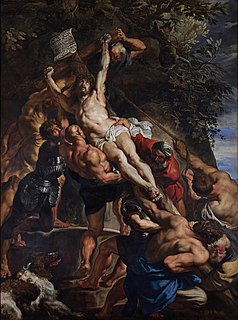
Flemish Baroque painting refers to the art produced in the Southern Netherlands during Spanish control in the 16th and 17th centuries. The period roughly begins when the Dutch Republic was split from the Habsburg Spain regions to the south with the Spanish recapturing of Antwerp in 1585 and goes until about 1700, when Spanish Habsburg authority ended with the death of King Charles II. Antwerp, home to the prominent artists Peter Paul Rubens, Anthony van Dyck, and Jacob Jordaens, was the artistic nexus, while other notable cities include Brussels and Ghent.
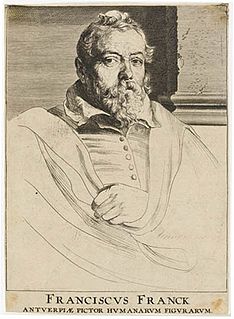
Frans Francken the Younger was a Flemish painter and the best-known member of the large Francken family of artists. Francken created altarpieces and painted furniture panels, but his reputation chiefly relies on his small and delicate cabinet pictures with historical, mythological, or allegorical themes. He played an important role in the development of Flemish art in the first half of the 17th century through his innovations in many genres including genre painting and his introduction of new subject matter. He was a frequent collaborator of leading Antwerp painters of his time.
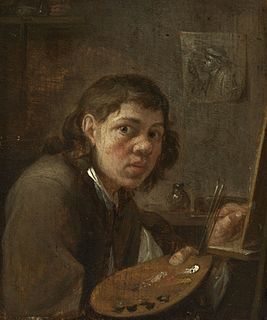
Gillis van Tilborgh or Gillis van Tilborch was a Flemish painter who worked in various genres including portraits, 'low-life' and elegant genre paintings and paintings of picture galleries. He became the keeper of the picture collection of the governor of the Habsburg Netherlands and travelled in England where he painted group portraits.

Dirck van Delen or Dirck Christiaensz van Delen was a Dutch painter who specialized exclusively in architectural paintings, principally depicting palace perspectives and church interiors.

Adriaen or Adriaan van Stalbemt or Adriaen van Stalbempt was a Flemish painter and printmaker who is known for his landscapes with religious, mythological and allegorical scenes. He was also a gifted figure painter who was regularly invited to paint the staffage in compositions of fellow painters.

Charles Emmanuel Biset or Karel Emmanuel Biset was a Flemish painter who had a peripatetic career working in various cities and countries including his hometown Mechelen, Paris, Annonay, Brussels, Antwerp and Breda. He worked in many genres including genre scenes of interiors with merry companies and gallery paintings, history painting, still life and portraiture.

Anton Goubau or Anton Goebouw was a Flemish Baroque painter. He spent time in Rome where he moved in the circle of the Bamboccianti, Dutch and Flemish genre painters who created small cabinet paintings of the everyday life of the lower classes in Rome and its countryside. He is known for his Italianate landscapes and genre paintings in the style of the Bamboccianti and his history paintings with mythological and religious themes.

Wilhelm Schubert van Ehrenberg or Willem Schubart van Ehrenberg (also: Wilhem Schubert von Ehrenberg or Wilhem Schubert van Ehrenberg was a Flemish painter mainly active in Antwerp who specialized in architectural paintings including of real and imaginary church interiors, Renaissance palaces and picture galleries.

Nicolaas van Eyck or Nicolaes van Eyck, was a Flemish painter active in Antwerp in the middle of the 17th century. He is known for his equestrian and battle scenes, landscapes and portraits. He also painted a few civil processions, including parades of the Antwerp civil militia.
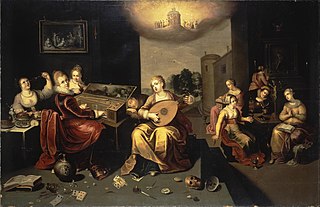
Hieronymus Francken the Younger or Hieronymus II was a Flemish painter and one of the most prominent members of the large Francken family of artists. Along with his brother Frans Francken II he played an important role in the development of new genres in Flemish art in the early 17th century.
Jan Baptist Tijssens the Younger (1660–1723) was a Flemish painter mainly known for his 'guardroom scenes' and still lifes. He was also active as an art dealer.
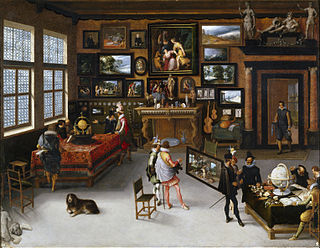
The Sciences and the Arts is a 17th-century painting which is part of the collection of the Museo de Prado in Madrid. It has traditionally been attributed to Adriaen van Stalbemt, but more recently some art historians have re-attributed the work to Hieronymus Francken the Younger.